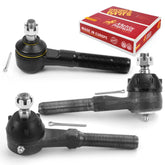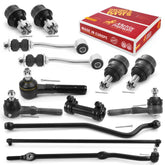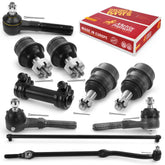An Overview of Steering System Components
The steering system in a vehicle is a fundamental part that plays a significant role in ensuring the driver's safety and control of the vehicle's direction. It is composed of several crucial components that work together seamlessly to facilitate smooth and confident turning of the vehicle. Without these critical components, a driver may experience difficulty maneuvering the vehicle, leading to potential accidents and mishaps on the road. Therefore, it is essential to understand the importance of the steering system and ensure that it is well-maintained to guarantee safe and efficient driving. These critical components include:
- Steering Wheel: The steering wheel serves as the primary means by which the driver controls the direction of the vehicle. It is securely attached to the steering column and provides a firm grip for confident and precise steering.
- Steering Column: A shaft that connects the steering wheel to the rest of the steering system. It may have various mechanisms to allow for adjustments like tilt and telescoping.
- Steering Gearbox: In older vehicles, this is a mechanical device that converts the rotational motion from the steering wheel into the lateral movement needed to turn the wheels. In modern vehicles, this is often replaced by a rack-and-pinion system.
- Rack and Pinion: A common type of steering system in which the rotational motion of the steering wheel is converted into linear motion using a gear (pinion) that engages with a toothed bar (rack). This motion pushes or pulls the tie rods to turn the wheels.
- Tie Rods: These are rods that connect the ends of the steering rack to the steering knuckles (wheel hubs). They transmit the steering force from the rack to the wheels, causing them to turn.
- Steering Knuckles: These are the parts that connect the wheels to the suspension system. They pivot when the tie rods are pushed or pulled, causing the wheels to turn.
- Power Steering System: In many vehicles, this system assists the driver's effort in turning the wheels, especially at low speeds or when parking. It can be hydraulic, electric, or electro-hydraulic.
- Steering Pump (Hydraulic System): If the vehicle has hydraulic power steering, a pump pressurizes hydraulic fluid, which assists in turning the wheels.
- Steering Wheel Position Sensor: In vehicles with electronic stability control and other advanced systems, sensors detect the position of the steering wheel to help with stability and safety features.
- Steering Shaft: A component that connects the steering wheel to the steering gearbox or rack-and-pinion system, transmitting the driver's input.
- Steering U-Joints: Flexible joints in the steering shaft that allow for slight misalignment while transmitting rotational motion.
- Steering Damper: Also known as a steering stabilizer, it reduces vibrations and oscillations in the steering system, contributing to smoother handling.
Proper steering is an essential component of vehicle control and safety. It allows the driver to navigate the direction of the vehicle with ease and confidence. However, choosing the right suspension part is equally important for your safety. You can't afford to compromise on the quality of the chassis part, as it can have a significant impact on your driving experience. That's why we highly recommend visiting Metrix Premium Chassis Parts' website to find the best-fitting suspension part for your vehicle. Our suspension kits are highly qualified and offer the best value. Don't take a chance with your safety on the road. Choose the best suspension part for your vehicle today at metrixpremiumparts.com.









